
Wine Culture and Information since 2002 - Volume 22
 Wine Culture and Information since 2002 - Volume 22 |
|
Issue 149, March 2016 |
Contents |
|
|
Tribute to Giacomo Tachis |
|
The world of wine has lost one of its highest and great interpreters, the one who made Italian enology great by starting a new and extraordinary era and taking it to the top of the Olympus. On 6 February 2016 Giacomo Tachis passed away, the man who, more than anyone else, has marked the irreversible path of Italian wine, by starting what can be defined as a renaissance. The greatest of them all, with no doubt at all. A great wine maker who has been capable, before anyone else in Italy, to understand wine needed to change and to change forever. Giacomo Tachis, who liked to call himself mescolatore di vini (”wine blender” in Italian), was born in Poirino, in province of Turin, Italy, on 4 November 1933. The same month in which was also born another great figure of the Italian wine and who contributed to the greatness of Italian enology: Luigi Veronelli. Two figures - Tachis and Veronelli - who have strongly and indelibly affected the fate of Italian wine. The former in vineyard and winery, the latter with his inimitable and unforgettable pen. The king of Italian wine makers passed away at 82 and passing on a heritage of magnificent wines, all capable of having relaunched the prestige of the Italian wine in the world. The wines signed by Giacomo Tachis are in fact many and all have been capable of surprising wine lovers all over the world. Writing a list of wines created by the intelligence and talent of Giacomo Tachis would be pretty long. It is however impossible not to mention his extraordinary contribution to the wines of Tuscany, including those made at Antinori and Marquis Niccolò Incisa della Rocchetta wineries. Tignanello, Solaia and Sassicaia have in fact his indelible signature and they gave new life to the enology of Tuscany while making it famous all over the world. The name of Giacomo Tachis is also associated to another great wine created by the far-sighted will of another nobleman of Italian wine: San Leonardo of Tenuta San Leonardo - in Trentino - of Marquis Carlo Guerrieri Gonzaga. San Leonardo is one of my favorite wines since ever, an absolute example of rare, noble and refined elegance, an inimitable masterpiece of a Bordeaux-style wine. In Tuscany Giacomo Tachis has also signed the wines of Querciabella, Castello di Rampolla, Argiano, Le Pupille, Alberese and Falchini. Wherever he went to, Giacomo Tachis has left his indelible mark with his wines. This is the case of Sardinia, where he signed great wines such as Turriga of Argiolas, Terre Brune of Cantina di Santadi and Barrua of Punica. Also in the other large Italian island - Sicily - the Piedmontese wine maker left his mark and signature. Including his collaboration with Istituto Regionale della Vite e del Vino and Duca di Salaparuta and Florio wineries. In Sicily he also signed the rare and exclusive wine Mothya produced with grapes cultivated in a tiny vineyard in the island of Mozia. Among the many wines created by the talent of Giacomo Tachis, there is also Pelago of Umani Ronchi winery - in the Marches - where he also understood the potential of their territory for the production of wines affected by noble rot and therefore by creating Maximo. In the Marches region, he also participated to the interesting project Il Pollenza. the great “mescolavino” (wine blender) - like he used to jokingly call himself - graduated in 1954 at Scuola Enologica di Alba (Enological School of Alba, Piedmont) and he has been a pupil of Émile Peynaud, the famous French wine maker, one of the greatest in the 1900s. The first important opportunity to show the world his talent and vision about wine was in 1961 when he was hired at Marchesi Antinori winery and where he will then become chief manager. Here Giacomo Tachis starts the Rinascimento of Italian wine, by beginning a new journey that will be then followed by many, and created Tignanello and Solaia. In a territory having a strong connection with its traditions such as Chianti, Giacomo Tachis had the courage of blending Sangiovese to the “foreigners” Cabernet Sauvignon and Cabernet Franc. He will also age his wine in barrique - at those time quite unknown in Italy - and makes one of the first wines in Chianti with no white berried grapes, the first Sangiovese to be vinified in barrique. An affront, like to say, to that tradition which will however and irreversibly change the fate of Tuscan wine and, of course, of Chianti. Giacomo Tachis was, first of all, a man of remarkable culture, curious and always willing to experiment, looking at a too far away horizon, simply too far away for many, but he then showed it everyone. To those who believe the style of Giacomo Tachis was, like to say, of French or international character, they should change their mind. This can also be because they never enjoyed the intense emotions his wines were capable of giving. It should in fact be said his respect for the territory and what the land of every place could offer was of primary importance. This has bee proved by most of his wines, in which he never forgot to pay a tribute to the grapes of the territory, such as Sangiovese, Montepulciano, Cannonau, Carignano and Nero d'Avola, just to mention a few. To understand him, we should recall what he said in 2010, when he announced his retirement from the world of wine: «Let's respect nature and the simplicity of wine. Reject chemistry the way we use it today and be careful of genetics, because nature rebels». The teaching Giacomo Tachis gave us is huge and fundamental, not only for the greatness of his wines, but also for his wine vision and his extraordinary professional career. The great Piedmontese wine maker also gave us a written proof of his thoughts in the book “Sapere di Vino” (”Knowing about Wine”, as far as I know, it is not available in English language). In his book, Giacomo Tachis tells about his professional career and his significant wine vision, by setting the roots of a future that, we hope so, will be continued by his many pupils. I never had the privilege to personally meet Giacomo Tachis and I am sure it would have been an amazing chance, as those who knew him have always told me he was a person of remarkable knowledge and culture. In a world, including wine's world, where there are many who show off an inconsistent and piteous vanity, listening to the one who made the history of Italian wine - with facts - would have been absolutely amazing and a true honor. I however have treasured the endless emotions his wines gave me and, in this sense, I enjoyed many of them and I keep a priceless memory for each of them. In this sense, it was an honor to meet Giacomo Tachis through his wines, it certainly was a privilege of which I thank him. A special thanks, nevertheless, for having started a new path for the Italian wine and for having relaunched the enology of Italy. A deep mark and clear path from which we cannot and we must not go back. Thank you Giacomo Tachis: your “mescolavino” art is and will always be source of pride for Italian enology and for those who love wine. Antonello Biancalana
|
||||
Contrasts of Primitivo and BarberaApulia and Piedmont meet up in our tasting by contrast and fill our glasses with two great grapes capable of amazing and opposed expressions |
|
Apulia and Piedmont are two distant regions and very different one from each other. The former, with its remarkable length, represents the “heel of Italy”, it is one of the most sunny regions of the country and it is affected by the influence of seas from which it is surrounded. Piedmont is in the other side of Italy, in a very different territory, facing the Alps and without reaching any sea. Both regions have a remarkable richness in grapes and wines - no region in Italy makes an exception in this - each having its own wine glories, equally great and extraordinary. Such as Primitivo and Barbera, the two grapes protagonists of our tasting by contrast, two opposed viticultural and enological expressions to interpret a wine. Important protagonists in their respective lands, both have a long and important history in the wine scene of Italy, giving wines of quite distant characters. Primitivo is capable of giving wines of good and full body, frequently characterized by good roundness and a pretty high content in alcohol. Barbera is very different, mainly known for its typical acidity, a well appreciated quality by its lovers. The two varieties have a good wine making versatility, in particular Primitivo which is also used for making robust sweet wines by using dried grapes. For the sake of truth, it should be said Barbera too, although marginally, is used for the production of sweet wines. Barbera and Primitivo are produced both in inert containers and those made of wood, including the barrique, therefore proving - in both cases - a good versatility in wine making. They however are two grapes and wines distant one from each other, enological expressions even opposed, with differences that - we will see - can be found in every aspect of sensorial tasting. The history of Primitivo is very interesting and only in recent times they have been successful in tracing its origin. A grape found in Apulia since a very long time, Primitivo takes its name from the characteristic of ripening before other varieties, and for this reason it is also called primaticcio and primativo (”prima” means before in Italian). The research on Primitivo origin begins at the end of the 1960s when they suspected some analogies with Zinfandel, a variety considered at those times indigenous to the United States of America and widely cultivated in California. Research done on DNA allowed in fact to discover Primitivo and Zinfandel were the same grape, although it was not possible to understand their origin. Later research allowed them to discover this grape had a certain connection with Plavac Mali grape, found in Croatia, and they believed it was the same variety. Subsequent researches allowed them to discover Primitivo - and therefore Zinfandel - is analogous to Crljenak Kaštelanski, a red berried grape found in Dalmatia. For this reason, some Primitivo producers write Zinfandel in the labels of their wines in order to have better commercial chances in the United States of America. It is however Primitivo and, sometimes, wines produced with this grape and labeled as Zinfandel are also found in the Italian market. Variety of a strong character, it is capable of giving wines with a good body and color, a quality that, in past times, made this grape to be mainly used in wines of other areas in order to give them more body and color. Primitivo is cultivated in many areas of Apulia and having in Manduria - in province of Taranto - its most famous and best territory and here it is also produced as a sweet style. This variety is also found, although marginally if compared to Apulia, in Campania and Abruzzo regions. Primitivo, which wines usually have a quite high alcohol content, is mainly vinified in cask, a technique giving more roundness to the wine while smoothing the intensity of tannins. Barbera is the most cultivated variety of Piedmont and it is one of the most common grapes in Italy as it is also found in other regions of the country. Barbera, along with Sangiovese and Montepulciano, is in fact among the most cultivated varieties in Italy and it is used in countless wines, both alone and blended to other grapes. It is believed Barbera originated from the Monferrato area, in Piedmont, and present in this territory since a very long time. Barbera has been a quite valued and appreciated grape of the past, until 1986 when it became sadly famous because of the well known and irresponsible Italian methanol scandal. This regrettable and deplorable event caused the intoxication of many people, with irreversible effects in many cases, including death. It will take all the obstinacy and determination of respectable and proud producers to give back to Barbera its dignity and prestige, in particular Giacomo Bologna, also known as Braida. It will in fact be this famous producer from Rocchetta Tanaro, in province of Asti, to commit himself to his Barbera and making of it one of the most successful and great grapes of Italy known everywhere in the world.
Barbera, besides being widely cultivated in Piedmont and in many regions of Italy, is also cultivated in other viticultural areas of the world, such as California and Argentina. A grape having a strong acidity, Barbera it is not particularly rich in polyphenols, making wines of crisp agreeableness and moderate astringency. The Piedmontese red grape proved with time interesting wine making versatility, as well as proving to be well suited for the production of different styles, including pleasing slightly sparkling wines. Barbera is now very successful in the world, becoming one of the grapes part of the Olympus of Bacchus during the 1990s, when drastic viticultural and wine making changes took place all over Italy. These changes, characterized by the research for quality and therefore the experimentation of new and modern wine making techniques, have allowed Barbera to be reevaluated even in the vinification in cask. Widely found in Piedmont, Barbera is a grape present in many denomitations of the region and, in particular, Asti and Nizza Monferrato, today recognized as Denominazione d'Origine Controllata e Garantita areas. (Denomination of Controlled and Guaranteed Origin) Our tasting by contrast will examine a Primitivo di Manduria and a Barbera d'Asti. These two wines will let us understand their remarkable differences, mainly expressed by the roundness and astringency in the first case, finesse and crispness in the second. Barbera is cultivated in many areas of Piedmont and each of them gives this grape characteristics strongly affected by soil and territory. As opposed to Barbera wines from other areas of Piedmont, the one produced in Asti is in fact characterized by a higher finesse and elegance. Something completely different, for example, in those made in Alba having a different composition of soil and characteristics of the territory, Barbera wines here are more robust and full bodied. We will taste two wines having no more than three year of aging and vinified in cask, therefore ensuring a good balance between tertiary qualities and characteristics of the grapes. Wines will be served in two tasting glasses at a temperature of 18 °C (65 °F). Let's pour the two wines in their respective tasting glasses and start the first part, the one about appearance evaluation. The first wine we will observe is Primitivo di Manduria. Let's tilt the glass over a white surface - a napkin or a sheet of paper will be enough - in order to assess the color at the base. We will observe an intense ruby red color, sometimes deep, and a low transparency: it will in fact be quite difficult to see an object behind the glass. Nuances of the color, observed at the edge towards the opening of the glass, will show an intense ruby red hue. Let's now pass to the evaluation of Barbera d'Asti. The color of this wine shows to the eyes of the taster an intense and brilliant ruby red color, while revealing a higher transparency than Primitivo di Manduria. Nuance of Barbera d'Asti confirms a brilliant ruby red hue. Let's now put the tilted glasses close one to each other and compare both wines in order to understand differences in color and transparency. Olfactory profiles of Primitivo and Barbera mainly express aromas of wild berries. The famous grape from Apulia mainly expresses aromas recalling black berried berries, whereas Barbera is more directly associated to red berries. In both grapes will also be perceived aromas recalling flowers, in particular violet. In Primitivo will be mainly perceived aromas of black cherry, plum and blackberry, whereas in Barbera will be cherry, raspberry and plum, also blackberry will be perceived sometimes. Both grapes offer a good versatility in the vinification in wood containers, a technique enriching the olfactory profiles of both wines with a higher complexity. Primitivo and Barbera, according to viticultural and wine making techniques, are capable of making wines with a good longevity and excellent chances of evolution. With time, these two varieties - provided they are kept in very good conditions - can in fact enrich their aromas with very complex sensations, offering an excellent case study to the nose of the taster. The first wine of which we will evaluate the olfactory profile is Barbera d'Asti. Let's hold the glass in vertical position and without swirling, then proceed with the first smell. To the nose are perceived aromas of cherry, raspberry and plum, followed by violet. Let's now swirl the glass in order to favor the development of aromas and, by tilting it, do a second smell. It will be perceived aromas recalling blackberry as well as sensations associated to wood, such as vanilla. Let's now pass to the evaluation of the opening of Primitivo di Manduria. The nose is evidently different and here it is perceived black cherry, plum and blackberry followed by violet, sometimes ever dried. After having swirled the glass, Primitivo completes its olfactory profile with blueberry, carob and sensations given by wood. Sometimes, in this wine, sensations of fruit can also get a character recalling jams. Let's now compare the two wines: in Primitivo we will notice a fuller and rounder olfactory profile than Barbera, in which will be perceived a more lively and crisp character. The gustatory analysis of the two wines let us continue the identification of differences in Primitivo di Manduria and Barbera d'Asti. Let's start this phase of the tasting by evaluating the Piedmontese wine. We will take a sip of Barbera d'Asti: the attack of this wine reveals the crisp character of this grape giving to the taste an evident acidic component, however very elegant. It should also be noticed the astringency in this wine, perceptible however not aggressive. In the mouth are perceived flavors of cherry, plum and raspberry, as well as the evident warm sensation of alcohol. The attack of Primitivo di Manduria is rounder and smoother than Barbera d'Asti, in which is also perceived a stronger astringency of tannins and a fuller body. In the wine from Apulia is also perceived a stronger effect of the alcohol, a characteristic also increasing the perception of roundness. The correspondence to the nose is very good: the perception of black cherry, blackberry and plum are dominant. The ending part of our tasting is about the final sensations perceived in the mouth and nose after having swallowed the wines. The finish of Barbera d'Asti has a good persistence, leaving in the mouth its typical flavors of fruits: in particular cherry, raspberry and blueberry. Crispness of acidity continues to be well perceived in the mouth after having swallowed the wine, leaving a sensation of pleasing elegance. The finish of Primitivo di Manduria is quite different from Barbera, also in this case having a good persistence. The sensation left in the mouth by the wine from Apulia is fuller and rounder, in which can also be perceived the burning effect of alcohol. It will also be perceived the typical flavors of this variety, in particular blackberry, plum and black cherry. According to a sensorial point of view, Primitivo and Barbera are two distant varieties, very different enological expressions however both capable of making wines of extraordinary and high quality.
|
||||||||||||
Wines of the Month |
|
|
|
Score legend Prices are to be considered as indicative. Prices may vary according to the country or the shop where wines are bought |
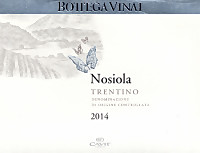
|
|
Trentino Nosiola Bottega Vinai 2014 |
|
| Cavit (Trentino, Italy) | |
 Nosiola Nosiola | |
| Price: € 6.50 | Score: |
 Intense greenish yellow and nuances of greenish yellow. Intense greenish yellow and nuances of greenish yellow. Intense, clean and pleasing, starts with hints of green apple, pear and
broom followed by aromas of peach, hazelnut, hawthorn and pineapple. Intense, clean and pleasing, starts with hints of green apple, pear and
broom followed by aromas of peach, hazelnut, hawthorn and pineapple.
 Crisp attack and however balanced by alcohol, good body, intense
flavors, agreeable. Crisp attack and however balanced by alcohol, good body, intense
flavors, agreeable.
 Persistent finish with flavors of green apple, pear and peach. Persistent finish with flavors of green apple, pear and peach. Aged in steel tanks. Aged in steel tanks. |
|
 Vegetable and crustacean appetizers, Risotto with fish, Sauteed crustaceans Vegetable and crustacean appetizers, Risotto with fish, Sauteed crustaceans |
|
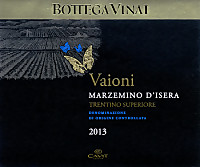
|
|
Trentino Superiore Marzemino d'Isera Vaioni 2013 |
|
| Cavit (Trentino, Italy) | |
 Marzemino Marzemino | |
| Price: € 13.50 | Score: |
 Intense ruby red and nuances of ruby red, little transparency. Intense ruby red and nuances of ruby red, little transparency. Intense, clean, pleasing and refined, starts with hints of black
cherry, violet and blueberry followed by aromas of raspberry, pomegranate,
plum, cyclamen, geranium, blackberry and pink pepper. Intense, clean, pleasing and refined, starts with hints of black
cherry, violet and blueberry followed by aromas of raspberry, pomegranate,
plum, cyclamen, geranium, blackberry and pink pepper.
 Properly tannic attack and however balanced by alcohol, good body,
intense flavors, pleasing crispness. Properly tannic attack and however balanced by alcohol, good body,
intense flavors, pleasing crispness.
 Persistent finish with flavors of black cherry, blueberry and
raspberry. Persistent finish with flavors of black cherry, blueberry and
raspberry.
 6 months in steel tanks, 4 months in bottle. 6 months in steel tanks, 4 months in bottle. |
|
 Cold cuts, Stuffed pasta with meat, Stewed meat with mushrooms, Cheese Cold cuts, Stuffed pasta with meat, Stewed meat with mushrooms, Cheese |
|
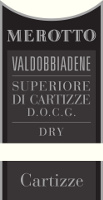
|
|
Valdobbiadene Superiore di Cartizze 2014 |
|
| Merotto (Veneto, Italy) | |
 Glera Glera | |
| Price: € 18.00 | Score: |
 Intense greenish yellow and nuances of greenish yellow, very
transparent, fine and persistent perlage. Intense greenish yellow and nuances of greenish yellow, very
transparent, fine and persistent perlage.
 Intense, clean, pleasing and refined, starts with hints of apple, peach
and wistaria followed by aromas of pear, jasmine, broom, tangerine, plum
and pineapple. Intense, clean, pleasing and refined, starts with hints of apple, peach
and wistaria followed by aromas of pear, jasmine, broom, tangerine, plum
and pineapple.
 Effervescent attack and pleasing sweetness, however balanced by
alcohol, good body, intense flavors, pleasing crispness. Effervescent attack and pleasing sweetness, however balanced by
alcohol, good body, intense flavors, pleasing crispness.
 Persistent finish with flavors of apple, peach and pineapple. Persistent finish with flavors of apple, peach and pineapple. Produced with the Charmat method. Produced with the Charmat method. |
|
 Aperitifs, Crustacean appetizers, Sauteed crustaceans, Risotto with vegetables Aperitifs, Crustacean appetizers, Sauteed crustaceans, Risotto with vegetables |
|
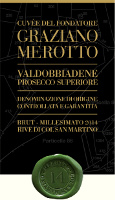
|
|
Valdobbiadene Prosecco Superiore Brut Rive Col di San Martino Cuvée del Fondatore Graziano Merotto 2014 |
|
| Merotto (Veneto, Italy) | |
 Glera Glera | |
| Price: € 17.00 | Score: |
 Intense greenish yellow and nuances of greenish yellow, very
transparent, fine and persistent perlage. Intense greenish yellow and nuances of greenish yellow, very
transparent, fine and persistent perlage.
 Intense, clean, pleasing, refined and elegant, starts with hints of
pear, wistaria and apple followed by aromas of peach, broom, hawthorn,
tangerine, pineapple, plum and mineral. Intense, clean, pleasing, refined and elegant, starts with hints of
pear, wistaria and apple followed by aromas of peach, broom, hawthorn,
tangerine, pineapple, plum and mineral.
 Effervescent and crisp attack, however balanced by alcohol, good body,
intense flavors, agreeable. Effervescent and crisp attack, however balanced by alcohol, good body,
intense flavors, agreeable.
 Persistent finish with flavors of pear, apple and peach. Persistent finish with flavors of pear, apple and peach. Fermented in closed tank for 50 days. Fermented in closed tank for 50 days. |
|
 Fish and crustacean appetizers, Sauteed crustaceans, Pasta and risotto with crustaceans Fish and crustacean appetizers, Sauteed crustaceans, Pasta and risotto with crustaceans |
|

|
|
Friuli Isonzo Friulano 2014 |
|
| Borgo San Daniele (Friuli Venezia Giulia, Italy) | |
 Friulano Friulano | |
| Price: € 18.00 | Score: |
 Brilliant straw yellow and nuances of straw yellow, very transparent. Brilliant straw yellow and nuances of straw yellow, very transparent. Intense, clean, pleasing and refined, starts with hints of apple, plum
and hawthorn followed by aromas of pear, peach, pineapple, almond, broom
and jasmine. Intense, clean, pleasing and refined, starts with hints of apple, plum
and hawthorn followed by aromas of pear, peach, pineapple, almond, broom
and jasmine.
 Crisp attack and however balanced by alcohol, good body, intense
flavors, agreeable. Crisp attack and however balanced by alcohol, good body, intense
flavors, agreeable.
 Persistent finish with flavors of apple, plum and almond. Persistent finish with flavors of apple, plum and almond. Aged in steel tanks. Aged in steel tanks. |
|
 Pasta and risotto with fish and crustaceans, Sauteed white meat, Fried fish Pasta and risotto with fish and crustaceans, Sauteed white meat, Fried fish |
|

|
|
Arbis Blanc 2013 |
|
| Borgo San Daniele (Friuli Venezia Giulia, Italy) | |
 Sauvignon Blanc (40%), Friulano (20%), Chardonnay (20%), Pinot Bianco (20%) Sauvignon Blanc (40%), Friulano (20%), Chardonnay (20%), Pinot Bianco (20%) | |
| Price: € 22.00 | Score: |
 Brilliant straw yellow and nuances of straw yellow, very transparent. Brilliant straw yellow and nuances of straw yellow, very transparent. Intense, clean, pleasing and refined, starts with hints of apple, plum
and banana followed by aromas of ripe peach, pear, elder, grapefruit,
hawthorn, mineral and hints of vanilla. Intense, clean, pleasing and refined, starts with hints of apple, plum
and banana followed by aromas of ripe peach, pear, elder, grapefruit,
hawthorn, mineral and hints of vanilla.
 Crisp attack and however balanced by alcohol, good body, intense
flavors, pleasing roundness. Crisp attack and however balanced by alcohol, good body, intense
flavors, pleasing roundness.
 Persistent finish with flavors of apple, plum and pear. Persistent finish with flavors of apple, plum and pear. Aged in cask. Aged in cask. |
|
 Fish soups, Pasta and risotto with fish and crustaceans, Broiled fish Fish soups, Pasta and risotto with fish and crustaceans, Broiled fish |
|
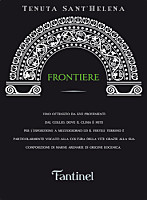
|
|
Collio Bianco Frontiere Sant'Helena 2013 |
|
| Fantinel (Friuli Venezia Giulia, Italy) | |
 Tocai Friulano (50%), Pinot Bianco (30%), Chardonnay (20%) Tocai Friulano (50%), Pinot Bianco (30%), Chardonnay (20%) | |
| Price: € 24.00 | Score: |
 Intense straw yellow and nuances of straw yellow, very transparent. Intense straw yellow and nuances of straw yellow, very transparent. Intense, clean, pleasing and refined, starts with hints of apple,
citrus fruits and jasmine followed by aromas of pear, peach, hawthorn,
banana, honey, almond, mineral and hints of vanilla. Intense, clean, pleasing and refined, starts with hints of apple,
citrus fruits and jasmine followed by aromas of pear, peach, hawthorn,
banana, honey, almond, mineral and hints of vanilla.
 Crisp attack and however balanced by alcohol, good body, intense
flavors, pleasing roundness. Crisp attack and however balanced by alcohol, good body, intense
flavors, pleasing roundness.
 Persistent finish with flavors of apple, plum and banana. Persistent finish with flavors of apple, plum and banana. Part of the wine ferments in cask. Part of the wine ferments in cask. |
|
 Stuffed pasta with fish, Roasted white meat, Roasted fish, Mushroom soups Stuffed pasta with fish, Roasted white meat, Roasted fish, Mushroom soups |
|
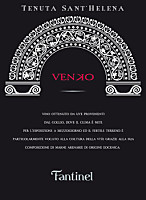
|
|
Collio Rosso Venko Sant'Helena 2009 |
|
| Fantinel (Friuli Venezia Giulia, Italy) | |
 Merlot (50%), Cabernet Franc (40%), Pinot Nero (10%) Merlot (50%), Cabernet Franc (40%), Pinot Nero (10%) | |
| Price: € 24.00 | Score: |
 Deep ruby red and nuances of garnet red, little transparency. Deep ruby red and nuances of garnet red, little transparency. Intense, clean, pleasing, refined and elegant, starts with hints of
plum, black currant and black cherry followed by aromas of dried violet,
blueberry, vanilla, tobacco, iris, chocolate, pink pepper, mace and
menthol. Intense, clean, pleasing, refined and elegant, starts with hints of
plum, black currant and black cherry followed by aromas of dried violet,
blueberry, vanilla, tobacco, iris, chocolate, pink pepper, mace and
menthol.
 Properly tannic attack and however balanced by alcohol, good body,
intense flavors, pleasing roundness. Properly tannic attack and however balanced by alcohol, good body,
intense flavors, pleasing roundness.
 Persistent finish with flavors of plum, black currant and black cherry. Persistent finish with flavors of plum, black currant and black cherry. 24 months in cask. 24 months in cask. |
|
 Roasted meat, Broiled meat and barbecue, Stewed and braised meat with mushrooms, Hard cheese Roasted meat, Broiled meat and barbecue, Stewed and braised meat with mushrooms, Hard cheese |
|
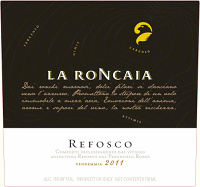
|
|
Colli Orientali del Friuli Refosco dal Peduncolo Rosso 2011 |
|
| La Roncaia (Friuli Venezia Giulia, Italy) | |
 Refosco dal Peduncolo Rosso Refosco dal Peduncolo Rosso | |
| Price: € 35.00 | Score: |
 Intense ruby red and nuances of ruby red, little transparency. Intense ruby red and nuances of ruby red, little transparency. Intense, clean, pleasing, refined and elegant, starts with hints of
black cherry, plum and black currant followed by aromas of blueberry,
violet, vanilla, raspberry, tobacco, chocolate, mace, pink pepper and
eucalyptus. Intense, clean, pleasing, refined and elegant, starts with hints of
black cherry, plum and black currant followed by aromas of blueberry,
violet, vanilla, raspberry, tobacco, chocolate, mace, pink pepper and
eucalyptus.
 Properly tannic attack and however balanced by alcohol, good body,
intense flavors, pleasing roundness. Properly tannic attack and however balanced by alcohol, good body,
intense flavors, pleasing roundness.
 Persistent finish with flavors of black cherry, plum and black currant. Persistent finish with flavors of black cherry, plum and black currant. 18 months in barrique, 6 months in bottle. 18 months in barrique, 6 months in bottle. |
|
 Roasted meat, Broiled meat and barbecue, Stewed and braised meat with mushrooms, Hard cheese Roasted meat, Broiled meat and barbecue, Stewed and braised meat with mushrooms, Hard cheese |
|
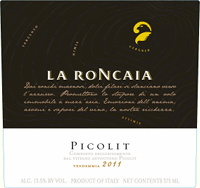
|
|
Colli Orientali del Friuli Picolit 2011 |
|
| La Roncaia (Friuli Venezia Giulia, Italy) | |
 Picolit Picolit | |
| Price: € 40.00 - 375ml | Score: |
 Brilliant amber yellow and nuances of amber yellow, transparent. Brilliant amber yellow and nuances of amber yellow, transparent. Intense, clean, pleasing, refined and elegant, starts with hints of
raisin, dried apricot and acacia honey followed by aromas of quince jam,
date, peach jam, candied fruits, citrus fruit peel, chamomile, vanilla,
lavender and nail polish. Intense, clean, pleasing, refined and elegant, starts with hints of
raisin, dried apricot and acacia honey followed by aromas of quince jam,
date, peach jam, candied fruits, citrus fruit peel, chamomile, vanilla,
lavender and nail polish.
 Sweet and round attack, however balanced by alcohol, good body, intense
flavors, pleasing crispness. Sweet and round attack, however balanced by alcohol, good body, intense
flavors, pleasing crispness.
 Persistent finish with flavors of raisin, dried apricot and acacia
honey. Persistent finish with flavors of raisin, dried apricot and acacia
honey.
 12 months in barrique, 6 months in bottle. 12 months in barrique, 6 months in bottle. |
|
 Dried fruit and jam tarts, Hard cheese Dried fruit and jam tarts, Hard cheese |
|
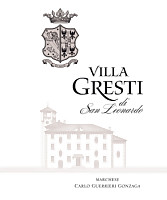
|
|
Villa Gresti 2010 |
|
| Tenuta San Leonardo (Trentino, Italy) | |
 Merlot (90%), Carmenère (10%) Merlot (90%), Carmenère (10%) | |
| Price: € 28.00 | Score: |
 Intense ruby red and nuances of garnet red, little transparency. Intense ruby red and nuances of garnet red, little transparency. Intense, clean, pleasing, refined and elegant, starts with hints of
black currant, black cherry and plum followed by aromas of violet,
blueberry, iris, raspberry, vanilla, tobacco, chocolate, face powder, pink
pepper, cigar box and eucalyptus. Intense, clean, pleasing, refined and elegant, starts with hints of
black currant, black cherry and plum followed by aromas of violet,
blueberry, iris, raspberry, vanilla, tobacco, chocolate, face powder, pink
pepper, cigar box and eucalyptus.
 Properly tannic attack and however balanced by alcohol, full body,
intense flavors, pleasing roundness. Properly tannic attack and however balanced by alcohol, full body,
intense flavors, pleasing roundness.
 Very persistent finish with long flavors of black currant, black cherry
and plum. Very persistent finish with long flavors of black currant, black cherry
and plum.
 14 months in barrique, 12 months in bottle. 14 months in barrique, 12 months in bottle. |
|
 Game, Roasted meat, Stewed and braised meat, Hard cheese Game, Roasted meat, Stewed and braised meat, Hard cheese |
|
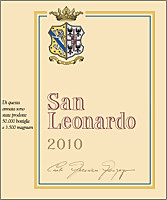
|
|
San Leonardo 2010 |
|
| Tenuta San Leonardo (Trentino, Italy) | |
 Cabernet Sauvignon (60%), Carménère (20%), Cabernet Franc (10%), Merlot (10%) Cabernet Sauvignon (60%), Carménère (20%), Cabernet Franc (10%), Merlot (10%) | |
| Price: € 55.00 | Score: |
 Intense ruby red and nuances of garnet red, little transparency. Intense ruby red and nuances of garnet red, little transparency. Intense, clean, pleasing, refined and elegant, starts with hints of
black currant, black cherry and violet followed by aromas of blueberry, plum,
iris, vanilla, cocoa, tobacco, coffee, mace, pink pepper, green bell
pepper, cigar box, clove and eucalyptus. Intense, clean, pleasing, refined and elegant, starts with hints of
black currant, black cherry and violet followed by aromas of blueberry, plum,
iris, vanilla, cocoa, tobacco, coffee, mace, pink pepper, green bell
pepper, cigar box, clove and eucalyptus.
 Tannic attack and however balanced by alcohol, full body, intense
flavors, agreeable. Tannic attack and however balanced by alcohol, full body, intense
flavors, agreeable.
 Very persistent finish with long flavors of black currant, black cherry
and blueberry. Very persistent finish with long flavors of black currant, black cherry
and blueberry.
 24 months in barrique, 12 months in bottle. 24 months in barrique, 12 months in bottle. |
|
 Game, Roasted meat, Stewed and braised meat, Hard cheese Game, Roasted meat, Stewed and braised meat, Hard cheese |
|
News |
|
In this section are published news and information about events concerning the world of wine and food. Whoever is interested in publishing this kind of information can send us a mail to our address.
|
Wine Guide ParadeDecember 2015
|
| |||||||
Privacy Policy | |||||||


| Copyright © 2002-2024 Antonello Biancalana, DiWineTaste - All rights reserved |
| All rights reserved under international copyright conventions. No part of this publication and of this WEB site may be
reproduced or utilized in any form or by any means, electronic or mechanical, without permission in writing from DiWineTaste. |